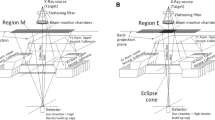Abstract
In small-field irradiation, the back-scattered radiation (BSR) affects the counts measured with a beam monitor chamber (BMC). In general, the effect of the BSR depends on the opened-jaw size. The effect is significantly large in small-field irradiation. Our purpose in this study was to predict the effect of BSR on LINAC output accurately with an improved target-current-pulse (TCP) technique. The pulse signals were measured with a system consisting of a personal computer and a digitizer. The pulse signals were analyzed with in-house software. The measured parameters were the number of pulses, the change in the waveform and the integrated signal values of the TCPs. The TCPs were measured for various field sizes with four linear accelerators. For comparison, Yu’s method in which a universal counter was used was re-examined. The results showed that the variance of the measurements by the new method was reduced to approximately 1/10 of the variance by the previous method. There was no significant variation in the number of pulses due to a change in the field size in the Varian Clinac series. However, a change in the integrated signal value was observed. This tendency was different from the result of other investigations in the past. Our prediction method is able to define the cutoff voltage for the TCP acquired by digitizer. This functionality provides the capability of clearly classifying TCPs into signals and noise. In conclusion, our TCP analysis method can predict the effect of BSR on the BMC even for small-field irradiations.







Similar content being viewed by others
References
Verhaegen F, Das IJ, Palmans H. Monte Carlo dosimetry study of a 6 MV stereotactic radiosurgery unit. Phys Med Biol. 1998;43:2755–68.
Sanchez-Doblado F, Andreo P, Capote R, Leal A, Perucha M, Arrans R, Nunez L, Mainegra E, Lagares JI, Carrasco E. Ionization chamber dosimetry of small photon fields: a Monte Carlo study on stopping-power ratios for radiosurgery and IMRT beams. Phys Med Biol. 2003;48:2081–99.
Capote R, Sanchez-Doblado F, Leal A, Lagares JI, Arrans R, Hartmann GH. An EGSnrc Monte Carlo study of the microionization chamber for reference dosimetry of narrow irregular IMRT beamlets. Med Phys. 2004;31(9):2416–22.
Patterson MS, Shragge PC. Characteristics of an 18 MV photon beam from a Therac-20 medical linear accelerator. Med Phys. 1981;8(3):312–8.
Yu MK, Slobada RS, Mansour F. Measurement of photon beam backscatter from collimators to the beam monitor chamber using target-current-pulse-counting and telescope techniques. Phys Med Biol. 1996;41:1107–17.
Lam KL, Muthuswamy MS, TenHaken RK. Measurement of backscatter to the monitor chamber of medical accelerators using target charge. Med Phys. 1998;25(3):334–8.
Watts DL, Ibbott GS. Measurement of beam current and evaluation of scatter production in an 18 MeV accelerator. Med Phys. 1987;14:662–4.
Huang PH, Chu J, Bjarngard BE. The effect of collimator backscatter radiation on photon output of linear accelerators. Med Phys. 1987;14:268–9.
Kubo H. Telescopic measurements of backscattered radiation from secondary collimator jaws to a beam monitor chamber using a pair of slits. Med Phys. 1989;16(2):295–8.
Verhaegen F, Tayler RS, Liu HH, Nahum AE. Backscatter towards the monitor ion chamber in high-energy photon and electron beams: charge integration versus Monte Carlo simulation. Phys Med Biol. 2000;45:3159–70.
Liu HH, Mackie TR, McCullough EC. Modeling photon output caused by backscattered radiation into the monitor chamber from collimator jaws using a Monte Carlo technique. Med Phys. 2000;27(4):737–44.
Rogers DWO, Faddegon BA, Ding GX, Ma CM, We J, Mackie TR. BEAM: A Monte Carlo code to simulate radiotherapy treatment units. Med Phys. 1995;22:503–24.
Chaney EL, Cullip TJ, Gabriel TA. A Monte Carlo study of accelerator head scatter. Med Phys. 1994;21:1383–90.
Duzenli C, McClean B, Field C. Backscatter into the beam monitor chamber: implications for dosimetry of asymmetric collimators. Med Phys. 1993;20:363–7.
Dunscombe PB, Nieminen. On the field-size dependence of relative output from a linear accelerator. Med Phys. 1992;19:1441–4.
Scrimger JW. Backscatter from high atomic number materials in high energy photon beams. Radiology. 1977;124:815–7.
Author information
Authors and Affiliations
Corresponding author
About this article
Cite this article
Suzuki, Y., Hayashi, N., Kato, H. et al. Prediction of back-scatter radiations to a beam monitor chamber of medical linear accelerators by use of the digitized target-current-pulse analysis method. Radiol Phys Technol 6, 142–150 (2013). https://doi.org/10.1007/s12194-012-0180-3
Received:
Revised:
Accepted:
Published:
Issue Date:
DOI: https://doi.org/10.1007/s12194-012-0180-3




